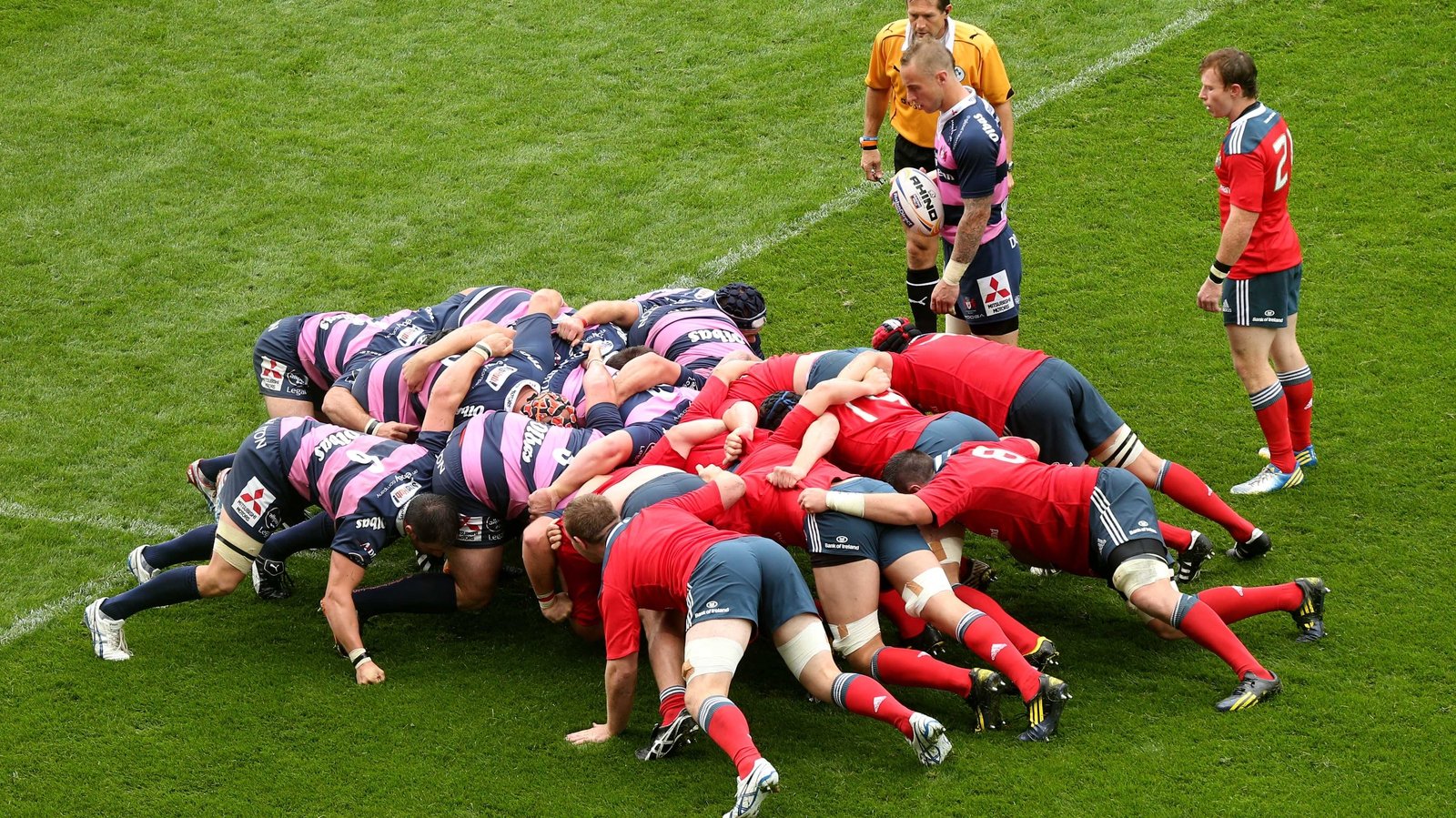I. Introduction
A. Definition and importance of a scrum in rugby:
A scrum in rugby is a method of restarting play after certain rule violations or stoppages, such as a knock-on or forward pass. It involves a tightly bound formation of players from both teams, with the objective of contesting possession of the ball. The scrum is a critical aspect of the game, as it provides an opportunity for teams to gain possession, demonstrate physical strength, and strategically restart the game.
B. Overview of what will be covered in the article:
This article will delve into the mechanics of a scrum in rugby, exploring the formation and positioning of players, the engagement and binding process, and the ball distribution and restart of play. The focus will be on the roles and responsibilities of the players involved and the key techniques employed. Additionally, the importance of the scrum within the context of a rugby match will be discussed.
II. The Mechanics of a Scrum
A. Formation and positioning:
- Formation of the scrum:
The article will outline the process of forming a scrum, including the initial crouch, bind, and set sequence. It will explain how players from each team bind together in a coordinated manner to create a stable and effective scrum formation. - Positions and roles of players in the scrum:
This section will discuss the specific positions of players within the scrum, such as the props, hookers, and locks. It will highlight their respective roles and responsibilities, including their contributions to maintaining stability, exerting force, and contesting possession.
B. Engagement and binding:
- Engagement process:
In this subsection, the article will explain the process of engagement, where the two sets of forwards come together with a combination of force and technique. It will explore the methods employed to gain a favorable position against the opposition and establish a strong foundation for the scrum. - Binding techniques and responsibilities of players:
This section will describe the binding techniques used by players to maintain a secure grip on their opponents. It will also explain the individual responsibilities within the scrum, such as the tight five working in unison to provide stability and force.
C. Ball distribution and restart of play:
- Hooker’s role in striking for the ball:
This subsection will focus on the pivotal role of the hooker, whose primary responsibility is to strike for the ball with their feet. It will explain the techniques employed and the timing required to gain possession and initiate the next phase of play. -
Scrum-half’s responsibility in distributing the ball:
The article will discuss the involvement of the scrum-half in the scrum, particularly their responsibility in collecting the ball from the hooker and distributing it to the backs or initiating a new attacking play.
III. The Importance of a Scrum in Rugby
A. Set-piece advantage
- Gaining possession through a scrum: In rugby, a scrum provides an opportunity for a team to gain possession of the ball. This set-piece advantage allows the team to assert control and dictate the course of play. Winning the scrum battle can turn the tide of the game in favor of the team with possession.
- Opportunities for strategic plays and scoring: The structured nature of a scrum creates a platform for teams to execute strategic plays and create scoring opportunities. Once possession is secured, teams can launch attacks by utilizing a combination of plays involving the backline or coordinated forward movements to breach the opponent’s defensive line.
B. Display of team strength and cohesion
- Displaying physical dominance and coordination:
The scrum is a physical test of a team’s strength and coordination. It serves as a platform for the forwards, often known as the engine room of the team, to exert their power and push against their opponents. A dominant scrum can showcase a team’s physical prowess and ability to work together as a cohesive unit. - Establishing momentum and psychological advantage:
A successful scrum can not only provide a team with possession but also help establish momentum. A dominant scrum can demoralize the opposing team and give the team in possession a psychological advantage. This boost in confidence can influence the outcome of the game by creating a winning mindset.
C. Compliance with the laws of the game
- Adhering to the Rugby Union laws and regulations:
The scrum is an integral part of the laws and regulations of rugby union. By actively participating in and adhering to the scrum laws, teams ensure fair play and maintain the integrity of the game. Scrums contribute to the overall flow and structure of the match, upholding the core principles of the sport. - Ensuring fair play and team discipline:
The scrum emphasizes discipline and teamwork. Players must follow specific rules and maintain discipline during scrum engagements, such as staying bound to their opponents and engaging safely. Scrums reflect a team’s ability to maintain discipline and work collectively toward a common goal.
IV. Evolution and Controversies Surrounding the Scrum
A. Changes in scrum laws and techniques over time
- Historical context and development of scrum laws:
The scrum has evolved over time due to safety concerns, player welfare, and the need for a fair and competitive contest. The laws surrounding the scrum have been refined to address issues such as collapsed scrums, dangerous play, and player positioning. - Modern modifications for player safety and fairness:
In recent years, scrum laws have been adjusted to prioritize player safety. Measures have been implemented to reduce the risk of injury, such as the introduction of mandatory binding techniques and stricter guidelines for engagement. These modifications aim to ensure the scrum remains a fair and safe aspect of the game.
B. Debates and controversies
- Safety concerns and injury risks:
The scrum is not without its controversies, as safety concerns persist due to the physical nature of the engagement. Discussions revolve around the potential for neck and back injuries, along with the impact on player welfare. - Criticisms about resetting scrums and time wastage:
Repeated scrum collapses and subsequent resets have drawn criticism for causing time wastage during matches. Concerns regarding deliberate collapsing or illegal tactics employed to disrupt the flow of the game have ignited debates on the effectiveness and fairness of scrums.
In conclusion, the scrum holds significant importance in rugby, offering set-piece advantages, displaying team strength and cohesion, and ensuring compliance with the laws of the game. While the scrum has undergone evolution and debates surrounding safety and fairness, its fundamental role in the sport remains vital. By understanding the mechanics, importance, and evolving nature of the scrum, players and fans alike can appreciate its significance in shaping the dynamics and outcomes of rugby matches.





